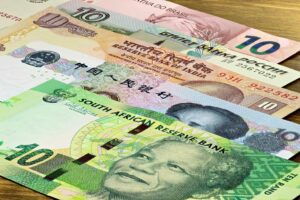A look at the day ahead in U.S. and global markets from Mike Dolan
Much like the slightly peculiar debt market nonchalance after December’s sticky inflation readout, world markets have remained calm and oil steady after U.S. and UK air strikes in Yemen aimed at protecting Red Sea shipping routes.
While the moves stoke fears of an escalation in the latest Middle East conflict, concrete action to secure disrupted shipping is equally seen as a positive for those worried about a prolonged hiatus in goods deliveries and higher transport costs.
Either way, oil markets were pretty sanguine on developments overnight – with prices only up about 2%, stuck in the same range seen for the past month and still down 6% year-on-year. Gold prices popped by even less.
Whether re-routed shipping stokes price rises in other goods is an open question, but it has not filtered through to wider market sentiment yet.
Even the slightly hot U.S. consumer price inflation report for December was batted away quite quickly on Thursday. U.S. annual headline and core inflation rates were a smidgen higher than forecast, even though the latter did indeed drop below 4% for the first time since May 2021.
Far from sowing seeds of caution in markets, Federal Reserve rate cut bets actually went up a gear. More than 150 basis points of cuts this year are back fully priced into futures curves, the odds on a March cut went up, and two-year Treasury yields dived to their lowest this year at 4.24%.
The rates retreat buoyed Wall St stocks, which closed only marginally in the red, and knocked back the dollar a bit. Futures are flat ahead of Friday’s open.
With weekly jobless updates also sparky, it was less than clear why markets reacted to an irksome CPI that way.
While not yet chiming with market easing bets, Fed officials didn’t seem bothered enough by the CPI readout to change their existing tone and some economists, such as Deutsche Bank, reckoned an outsize spur to CPI from shelter prices is less of an issue for Fed-favoured PCE inflation measures.
“When we have weeks or months of data to come, I don’t like tying our hands,” Chicago Fed boss Austan Goolsbee told Reuters. “We don’t make decisions about March, June and whatever, in January.”
Whatever the real reason for the market take, they get a second view of inflation pressures later on Friday as a likely more subdued U.S. producer price report for December is released.
And whatever price pressures are still evident in U.S. and other western economies, there’s none at all in China – consumer prices there declined for a third month in December while factory-gate prices extended their prolonged deflationary slide with a surprisingly large annual drop.
With the Taiwan election also due on Saturday, China’s stock markets remained in the dour mood they’ve been in for months and ended the week in the red.
The contrast with Japan’s roaring , which added another 1.5% on Friday and has now surged more than 6% so far this year to its highest since 1990, could hardly be starker.
Back on Wall St, the fourth quarter earnings season hoves into view on Friday.
U.S. banking giants are expected to report lower profits for the fourth quarter after they set money aside to cover souring loans while also paying more to depositors.
The largest banks’ net interest income probably fell on average 10% in the fourth quarter, Goldman Sachs analysts said. An estimated 15% decline in trading revenue will also weigh on earnings, they said.
But perhaps of most interest to wider markets is the level of loan loss provisioning that’s starting to emerge.
Key diary items that may provide direction to U.S. markets later on Thursday:
* U.S. Dec producer price inflation report
* Minneapolis Federal Reserve President Neel Kashkari speaks
* U.S. Corporate earnings: JPMorgan, Citi, Bank of America, Wells Fargo, Bank of New York Mellon (NYSE:), BlackRock (NYSE:), UnitedHealth (NYSE:), Delta Airlines (NYSE:)
(By Mike Dolan, Editing by Hugh Lawson mike.dolan@thomsonreuters.com)
Read the full article here











